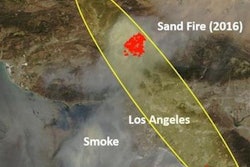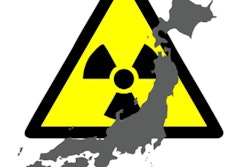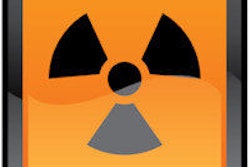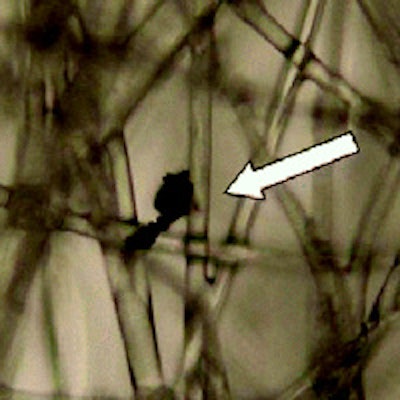
Radiologists at a Japanese hospital were baffled when dark spots began appearing on computed radiography (CR) images in March 2011. They discovered that the spots were caused by fallout from the nuclear disaster at the nearby Fukushima Daiichi nuclear power plant, according to an article in the American Journal of Roentgenology.
Researchers believe the spots represent radioisotopes from the Fukushima Daiichi accident that were suspended in the air as particulate matter. The radioisotopes filtered into CR imaging plates (IPs) to create artifacts on images. Even today, black spots are still appearing on some images, according to the team led by Yasuhiro Kashimura.
The artifacts have not impeded the diagnostic abilities of radiologists at the hospital, and the fallout itself does not represent any more of a health hazard than normal background radiation. But the issue has forced staff members at the hospital to change how they handle CR imaging plates to contain the contamination (AJR, August 21, 2015).
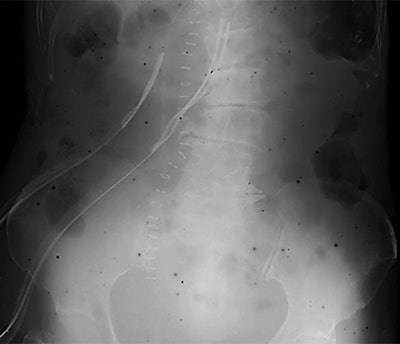 Mobile x-ray image of an 80-year-old-woman with ileus, obtained on March 18, 2011, showing dark spots. All images courtesy of AJR.
Mobile x-ray image of an 80-year-old-woman with ileus, obtained on March 18, 2011, showing dark spots. All images courtesy of AJR.Worst nuclear disaster since Chernobyl
Iwaki Kyoritsu General Hospital is located in the town of Iwaki, about 40 km from the Fukushima Daiichi nuclear power plant. The 828-bed hospital is one of the major centers for medical care in the Fukushima prefecture, treating about 950 outpatients a day on average.
On the afternoon of March 11, 2011, the region was rocked by a massive 9.0-magnitude earthquake centered off the Tohoku region of the northern Japanese coast. The earthquake triggered a devastating tsunami that severely damaged the nuclear plant in what's been called the worst nuclear disaster since Chernobyl.
The accident spewed radioactive material into the skies and ocean waters around Japan and around the world. As nuclear experts struggled to deal with the disaster, radiology personnel at Iwaki Kyoritsu began noticing black spots on CR images -- a phenomenon also experienced at several other hospitals in Japan.
It didn't take long for staff to connect the black spots to fallout from Fukushima. They tested combinations of imaging plates and cassettes used both before the disaster and after October 2011, when most (but not all) of the fallout had subsided. They found that the spots occurred only in images from old cassettes, which suggests that radioisotopes from the fallout had entered CR cassettes and were adhering to material inside, particularly the cassette's inner lining of felt that acts as a buffer for the imaging plate.
Kashimura and co-author Koichi Chida, PhD, confirmed their suspicions using optical microscopy, which detected pieces of suspended particulate matter in the felt of an older cassette in use at the time of the disaster. They cut out the piece of felt and inserted it into a new cassette in which the latent image had been erased from the imaging plate. Black spots appeared, corresponding to the locations on the piece of older felt.
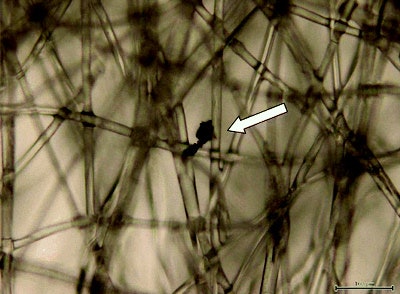 Microscopy photograph of felt from a CR cassette in use at the time of the Fukushima disaster. Suspended particulate matter (arrow; approximately 30-40 µm in diameter), which included cesium-134 and cesium-137 radioactivity, can be seen.
Microscopy photograph of felt from a CR cassette in use at the time of the Fukushima disaster. Suspended particulate matter (arrow; approximately 30-40 µm in diameter), which included cesium-134 and cesium-137 radioactivity, can be seen.A threat to patients?
How much radiation is being emitted by the particles, and does it represent a threat to patients? Not much, and no, the investigators believe. The radioactivity of the particulate matter was below the detection limit of a radiation detector held only 15 mm away from the surface of the cassette. The level detected was the same as the measured background radiation level of the hospital at the time, and it didn't change regardless of whether old or new cassettes were being examined.
"Therefore, any effects on humans of the radioactive material ... that caused the black spots on CR images can be ignored," the authors wrote. "That is, the health implications of the dose from individual contaminated cassettes are negligible, although the effects on human health from the radioactive fallout generally remain unclear."
Kashimura and Chida believe that in the early stages of the disaster, in March and April 2011, the spots were probably caused by iodine-131 (I-131), which was discharged in large amounts by the Fukushima reactor. But I-131 only has a half-life of eight days, and the spots continued to show up six months after the accident; this led the researchers to believe that later spots may be caused by cesium-137 (Cs-137) and cesium-134 (Cs-134), which have half-lives of 30 and two years, respectively.
Ironically, the researchers found no black spots on digital images acquired by flat-panel digital radiography (DR) systems. They speculated that the difference could be due to the radiation storage potential of CR imaging plates, or the high sensitivity of CR technology.
How has the staff at Iwaki Kyoritsu General Hospital adapted to the situation? While radioactive material on the surface of a cassette or IP can be wiped off, isotopes adhering to the felt inside the cassette cannot be removed. Therefore, radiology personnel should erase latent images from an imaging plate immediately before clinical use, and read the IPs quickly after an x-ray exam.
As a side note, the researchers pointed out that this issue probably was not observed after other nuclear disasters such as Three Mile Island in 1979 and Chernobyl in 1986, as computed radiography was not in widespread use at the time.
While the problem has subsided somewhat since the disaster, personnel from Iwaki Kyoritsu are still dealing with fallout -- both literal and metaphorical -- four years later.
"Although fewer black spots were detected in radiographic images taken after April 2011, some were still observed more than six months later," Kashimura and Chida wrote. "Furthermore, we still observe some black spots even today."




